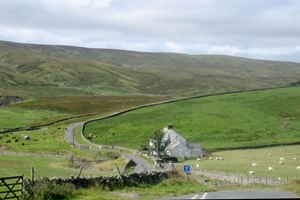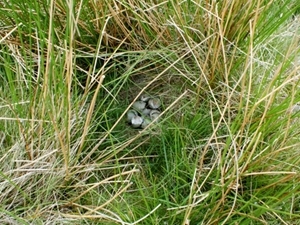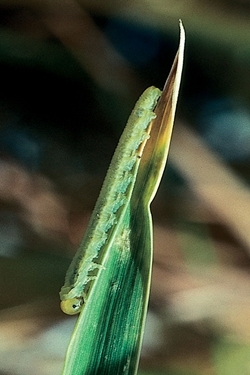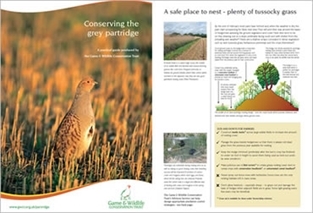Key points
- Grey partridge are typically thought of as birds of arable farmland, but in the uplands of northern England they are found on hill farms where arable is absent.
- This paper studies their habitat use, nesting sites and chick diet in these grassland habitats.
- The scientists used radio tracking to study pairs and broods during the breeding season.
- On hill farms, grey partridges preferred rough grazing habitats, with rushes providing nesting cover and sawfly larvae being a key component of chick diet.
Background
 The grey partridge was common and widespread until the Second World War, but the population has severely declined in recent decades. Changes in farming methods, including the widespread use of herbicides and removal of hedgerows, banks and field margins have been partly responsible, along with increased predation on nests and chicks. Although environmental schemes to support the partridge by easing these pressures have been introduced, the population has not recovered.
The grey partridge was common and widespread until the Second World War, but the population has severely declined in recent decades. Changes in farming methods, including the widespread use of herbicides and removal of hedgerows, banks and field margins have been partly responsible, along with increased predation on nests and chicks. Although environmental schemes to support the partridge by easing these pressures have been introduced, the population has not recovered.
Grey partridge are typically thought of as birds of lowland arable farmland. However, on hill farms in the uplands of northern England, they are found in rough grassland habitats without arable farming. Numbers seem to be stable in these areas, but little was known of their habitat requirements. This study looked at their habitat use, nest site preferences, chick diet and breeding success.
What they did
 The authors studied grey partridge during the breeding season on hill farms in Upper Teesdale, County Durham, over three years (2010-2012). Farming in the area is mainly sheep, with some beef cattle. Traditionally managed hay meadows and rush pastures dominate the valley bottoms around the farms. On the valley sides, more lightly grazed rough grasslands join heather moorland on the high ground.
The authors studied grey partridge during the breeding season on hill farms in Upper Teesdale, County Durham, over three years (2010-2012). Farming in the area is mainly sheep, with some beef cattle. Traditionally managed hay meadows and rush pastures dominate the valley bottoms around the farms. On the valley sides, more lightly grazed rough grasslands join heather moorland on the high ground.
72 adult partridges were caught at night and fitted with a radio transmitter so the scientists could monitor their location. Every two weeks the birds were located. The location data were used to identify the “home range” of pairs during the breeding season and the habitat within each was quantified using a land cover map.
For 25 nests, the habitat immediately surrounding the nest was recorded, and nests were visited every four days to observe hatching success/predation/abandonment. At six weeks post hatching, broods were revisited to determine brood size and survival.
Droppings from 29 brood roosts were collected to examine the composition of chick diet, when chicks were 4-26 days old. The insects that were eaten can be identified from body fragments in the droppings, which allowed the scientists to determine the invertebrates that were important in the chick diet.
What they found
 During the breeding season, both pairs and broods preferred rough grazing habitats. 69% of nests were in rough grazing, with tall rush providing nest cover.
During the breeding season, both pairs and broods preferred rough grazing habitats. 69% of nests were in rough grazing, with tall rush providing nest cover.
Hens laid an average of 12 eggs (range between 6-17). Nest survival (the likelihood of a nest hatching a chick) varied between years, and so did breeding success (number of chicks reared per pair), with no chicks reared to fledging in 2012, the wettest June recorded since 1910.
The diet of chicks varied with habitat and chick age. Young chicks (less than one week old) in rough grazing habitats ate mainly sawfly larvae (46%) and ants (34%). Older chicks in these habitats ate sawfly larvae (27%) and ants (23%), but also beetles (21%), predatory wasps (6%) and other insects (sawfly adults, craneflies) (14%). This was different in enclosed fields (rush pasture, sparse rush pasture and meadow), where the main prey of young chicks were predatory wasps (24%) and sawfly larvae (15%), with beetles (49%) the main prey of older chicks.
What does this mean?
 This study found several differences between the chick diet and habitat preferences of grey partridge on hill farms in the Pennines, compared to their typical arable lowland habitat. On hill farms, breeding grey partridges preferred rough grazings, where chicks preferred sawfly larvae. Nesting habitats and the importance of sawfly larvae in chick diet were similar to that of black grouse, which share these rough grazing habitats in the uplands of northern England. Chick survival is a key driver of population change in grey partridges, so increasing the availability of sawfly larvae may help mitigate against the negative impact that poor weather can have. More knowledge of how to manage grass and rush swards to increase numbers of sawfly larvae is needed to help chick survival for both grey partridge and black grouse in these upland grasslands.
This study found several differences between the chick diet and habitat preferences of grey partridge on hill farms in the Pennines, compared to their typical arable lowland habitat. On hill farms, breeding grey partridges preferred rough grazings, where chicks preferred sawfly larvae. Nesting habitats and the importance of sawfly larvae in chick diet were similar to that of black grouse, which share these rough grazing habitats in the uplands of northern England. Chick survival is a key driver of population change in grey partridges, so increasing the availability of sawfly larvae may help mitigate against the negative impact that poor weather can have. More knowledge of how to manage grass and rush swards to increase numbers of sawfly larvae is needed to help chick survival for both grey partridge and black grouse in these upland grasslands.
To conserve grey partridges on these hill farms, it is important that rough grazings are retained and grazing regimes practised to provide suitable habitat for sawfly larvae to thrive.
Read the original abstract
Warren, P., Hornby, T., & Baines, D. (2017). Habitat use, nest-sites and chick diet of Grey partridge Perdix perdix on hill farms in north east England. Bird Study, 64: 138-145.
Get your FREE Grey Partridge Conservation Guide
An essential guide to conserving the grey partridge produced by the Game & Wildlife Conservation Trust.
What's inside your FREE guide
✓ The decline of a common farmland bird
✓ A safe place to nest - plenty of tussocky grass
✓ Chick survival - insect food is crucial
✓ Surviving winter and spring - food and cover
✓ Conservation targets - Partridge Count Scheme
✓ Grey partridges and shooting
✓ Common questions
Download guide now >